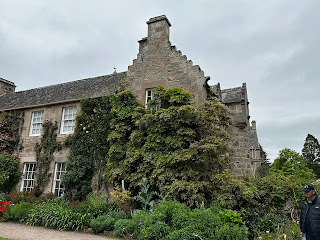 |
| Another photo of the ship as we drove away on a cool and overcast morning. According to Fiona, it would clear up in the afternoon - and it did! |
 |
| More sheep - and later on, from Fiona, the reason why there is a black one in every flock. |
When we arrived at the Cawdor Estate outside of the town of Nairn, we started with a 30 minute walk through part of the natural woodland near the main buildings. The Cawdor Estate is actually a holding over over 750 acres which comprises the Castle and Gardens, woodlands for some forestry, agriculture and sheep farms.
The castle and the family have a very long history, and there's quite a story that goes with the building itself. The Thane of Cawdor who had a fortification nearby in the late 1300s, decided to build a new, stronger tower. In a dream, he was told to put some gold on a donkey's back and let it roam for a day. Wherever it lay down to sleep was where the new castle should be built, and if he did he would remain prosperous. The donkey lay down under a Holly Tree, and that's where the castle was built starting in 1454. The remains of the tree are actually enclosed in one of the castle's rooms today, and the descendants of the original Thane still own the castle and estate lands, although the name has gone from Calder to Cawdor to Campbell. The 6th Earl of Cawdor passed away only recently, and now his wife, the Dowager Countess Angelika, runs the estate. She and her stepson, the heir, had a bit of a falling out in the early 2000s, but it looks like the Campbell family will be able to continue the 600 year old legacy.
After our little ramble in the wood, we went into the Castle and Gardens and toured the inside. Now that everyone has audioguides it is much quicker and easier to make your way around. The Dowager Countess still lives in the castle in the winter, but as it is open for tourists from May to September, she moves to a smaller cottage nearby on the estate during the summer. Apparently, all of the rooms we walked through are actually used and not just for show.The castle gardens are also quite impressive, and we had 45 minutes or so to wander around them.
 |
| Blue Iceland Poppies and Black Irises make an interesting combination |
 |
| This fish doesn't stream water, he squirts it. Somebody has quite a sense of humour! |
 |
| The azaleas and small rhododendrons in the gardens make beautiful splashes of colour. |
And just in case you have a little extra time, the Estate even has a 9-hole golf course! It costs 15 Pounds or so for a round, and you can rent clubs.
On our way towards the unplanned quick stop at Culloden, at which we had made an in-depth visit in 2013, Fiona told us why every flock of sheep had to include a black one. It turns out that the foxes who would attack the sheep thought the black ones were dogs, so they would keep away. So the black sheep of the family does actually have some use!
We made a 20 minute stop at the Visitor Centre at Culloden Battlefield, which is where the Jacobites under Bonnie Prince Charlie, who wanted to restore the Stuarts to the British throne, rose up and fought against the Duke of Cumberland and the British Army in 1746. The battle here was very short, only about an hour, but at the end 1,500 Jacobites and 100 British troops were slain.
 |
| Leanach Cottage, which was a field hospital for government soldiers during the battle |
 |
| There are flags on the battlefield showing the front lines of both sides |
As we prepared to sail away, we heard the sounds of a piper on the pier. He played until we were a distance from the pier, and gave us all a final Highland wave goodbye.
When we sailed out of Invergordon that evening, we passed a couple of oil rigs. Invergordon is known for two things in Scotland - repairing and maintaining rigs for the North Sea oil industry, and having the biggest whisky distilleries we've ever seen. Much of the agriculture in the area is hay for the sheep in winter and barley for making whisky.















No comments:
Post a Comment